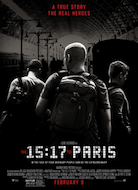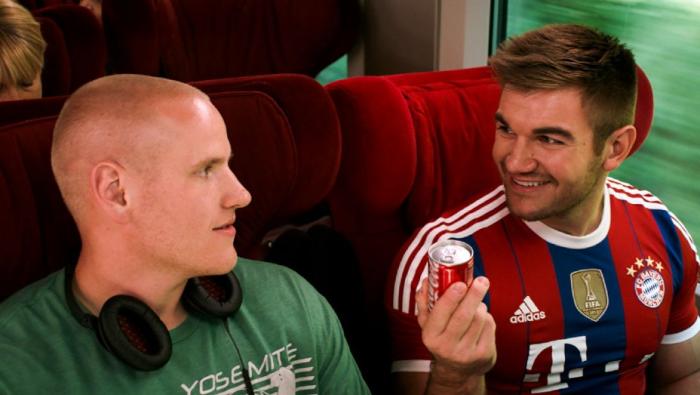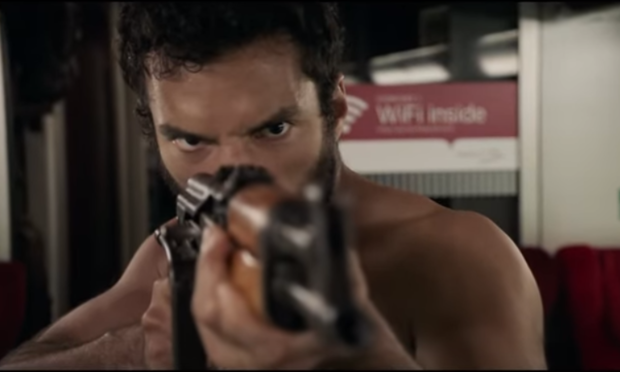by Eric Blume
 Has Clint Eastwood lost his mind? That’s the thought that swirled through my mind for the first hour of 15:17 To Paris, because every choice is so shockingly wrong-headed that it feels unfathomable. Say what you will about Eastwood’s films, but even his detractors would need to admit that his movies are generally well-acted and sure-footed. I had to stay through the end credits not to see the name of the cinematographer, but to ensure that there actually was one. In fact, it’s Tom Stern, who has shot most of Eastwood’s films. Out of respect for these two gentlemen and their intelligent work together in the past, let's assume that on this film they were attempting to take Eastwood’s infamously brisk, limited-takes directorial and shooting style to its ultimate breakneck limit. Their new film looks uglier and less artful than your average TV procedural...
Has Clint Eastwood lost his mind? That’s the thought that swirled through my mind for the first hour of 15:17 To Paris, because every choice is so shockingly wrong-headed that it feels unfathomable. Say what you will about Eastwood’s films, but even his detractors would need to admit that his movies are generally well-acted and sure-footed. I had to stay through the end credits not to see the name of the cinematographer, but to ensure that there actually was one. In fact, it’s Tom Stern, who has shot most of Eastwood’s films. Out of respect for these two gentlemen and their intelligent work together in the past, let's assume that on this film they were attempting to take Eastwood’s infamously brisk, limited-takes directorial and shooting style to its ultimate breakneck limit. Their new film looks uglier and less artful than your average TV procedural...
You know the film’s plot and gimmick: Eastwood recreates the 2015 Thalys train terrorist attack, and has cast the three real life heroes to play themselves. This proposition was potentially interesting on paper, but unfortunately the three young men have little screen charisma, and appear both overeager and uncomfortable onscreen. They’re either trying too hard (the film’s lead, Spencer Stone) or not hard enough (Anthony Sadler and Alek Skarlatos). We’re not talking about the fact that these men aren’t professional actors who can give us things like subtext, complexity, or characterization. That's a given. We’re talking painful line readings, awkward timing, and clumsy self-awareness.

Not that Eastwood's direction of his cast helps. The young actors who play middle-school versions of the three subjects manage to be precocious “movie kids” and there’s not an unstagy, honest moment in any of their scenes. For some reason Eastwood has cast a group of smart comically gifted actors in small roles (Judy Greer, Tom Lennon, Jenna Fischer, Tony Hale) but then uses none of their natural spark. Greer and Fischer’s individual scenes where they talk about God* are glorious unintentional howlers (I picture their significant others tormenting them by repeating their lines at home).
The film takes place in three sections: the “back-story” of the young boys; the European vacation leading up to the train incident; and the attack. To say that nothing happens in those first two sections, is to be generous. We learn nothing about the characters, there’s no narrative progression, and no event adds texture. There’s a full thirty minutes in this movie where the guys go to Rome, Venice, Germany, and Amsterdam and take selfies. I wish I were making this up.

There’s one moment at the start of the train attack when the terrorist (Ray Corasani) stares into the bathroom mirror before he begins to strap on his weapons. This actor fills the moment with such intensity, and it’s the first time we feel there’s an actual human being feeling something powerful and real. It makes you wonder why Eastwood would hire the “actual human beings” who lived this story, and not fill the screen with actors who could convey their true passion.
The film is a particular disappointment after last year’s Sully, which intelligently deconstructed the idea of heroism. Eastwood worked to produce a skillful performance from Tom Hanks that slowly unlocked the layers of a regular person anointed hero status, but unable to grapple its meaning and purpose. It’s difficult to believe 15:17 To Paris comes from the heart or mind of the same man.
* I have no problem with people of deep faith and sometimes bemoan their lack of representation. What I do feel is problematic is how Hollywood often (and certainly here) uses characters who talk about faith and God as shorthand for Fine, Upstanding Americans... instead of actually dramatizing that faith.